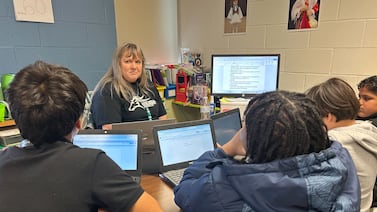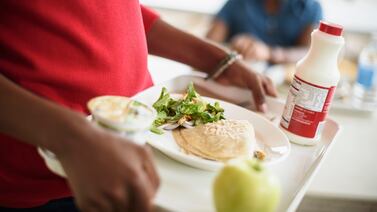The first wave of teachers are expected to return to Chicago’s public schools in the new year, but Erin Young isn’t sure yet if she’ll be among them.
Remote learning has been difficult for her students at Luther Burbank Elementary on the Southwest Side. But COVID-19 could be deadly for Young, who is in a high-risk category and, she fears, for some of her students with severe disabilities.
“I have struggled with the decision,” said Young, who teaches special education cluster students from kindergarten to second grade. “I’m getting a lot of pressure from my family” not to go in.
Empty of students since March, Chicago’s public schools are moving again to reopen their doors. The district has announced staggered reopening dates for students in kindergarten to eighth grade starting in January. But among the biggest questions about reopening is this: How many teachers will return next year?
The answer depends on how many individual teachers request health accommodations or unpaid leave. It also hinges on the outcome of the increasingly tense relationship between the school district and the city’s teachers union. Union leaders have shown they are willing to press their case in the labor court system and the court of public opinion, filing labor grievances and calling for car caravan protests about reopening plans. But some critics say they also haven’t clearly outlined the specific conditions in which they would support a return to school buildings.
The intensity of the conflict is reminiscent of last fall, when teachers walked out on an 11-day strike over pay raises and hiring more social workers and nurses.
Now district leaders say the question of whether to reopen schools is no longer up for discussion. They don’t expect to have a written agreement with the union ahead of January’s reopening, and they plan to press ahead without it.
“Our desire always is to have an agreement with the union on how we educate kids,” schools chief Janice Jackson told Chalkbeat this month. “But I don’t see that on horizon anytime soon.”
The union, meanwhile, this week filed an appeal in labor court to stop reopening altogether until there is a written agreement on safety protocols around reopening, and could weigh a strike vote timeline in coming weeks.
The dispute has left Chicago teachers like Young wondering what to do — take an unpaid leave, prepare for a labor action, or plan for a return to school buildings.
“The stakes are so high,” said Young, who wants more guidance about how to teach students with disabilities and enforce social distancing or following behavior rules. She worries about the health of her students who are at higher risk.
She’s not alone. Sean Eichenser, an eighth grade teacher at an elementary school on the Northwest side, said he applied for a health-related accommodation to avoid returning to in-person work. He is now anxiously counting down the days until Feb. 1, when K-8 students are expected to return. “I keep looking at my calendar in February and thinking, ‘What are we doing?’” said Eichenser, who is worried COVID-19 rates will only get higher during the winter.
Others have said they will return to classrooms, even if they are nervous. “I’m a teacher, and it’s my job to take care of the kids and show up at school,” said Tim Daly, who teaches special education cluster students at Schurz High School in Irving Park. “I see the parents in my Zoom calls every day and they need help.”
Teachers had to inform the district by Monday if they would return to school buildings and whether they would need accommodations. An earlier round of “intent to work” forms showed 42% of teachers would return without seeking an accommodation. Meanwhile, in separate parent surveys for pre-kindergarten and special education families, 34% said they would choose an in-person learning option, the district said.
Those numbers, and how they line up, pose a logistical challenge for Chicago schools, which will need to juggle staffing, learning pods that alternate days under a hybrid plan, and a new landscape for teachers who will be expected to teach both in-person and remote students at the same time. The district has said it will expect teachers to report to buildings even if most of their class remains remote.
For teachers who apply for special exemptions, or take a leave, there are several options, but it’s unclear under what conditions, and staffing constraints, they’ll be given.
Employees who have medical conditions that the Centers for Disease Control and Prevention consider high risk can apply to work remotely under the American with Disabilities Act, according to the district. But that’s no guarantee: “While they are considered a priority, not all ADA requests will be approved for full telework depending on the specific circumstances,” according to a district statement.
Teachers may also be eligible for leave through the Family and Medical Leave Act, or FMLA, public health emergency leave for educators who are struggling to find child care, or unpaid leave that may not come with any job protection.
Other cities give some sense of what reopening has looked like for teachers. In New York City, the union and school district came to an agreement on reopening, but the plan discouraged principals from assigning teachers to juggle learning pods and fully remote students, leading to a staffing crunch. The district gave roughly 21% of teachers permission to work from home for health reasons this fall.
In Washington D.C., some students returned to school in November but, without an agreement with the city’s teachers union, educators didn’t return and students were supervised by non-teaching staff.
Other teachers unions have also taken their fight to the courts, with mixed results. In Florida, the statewide teachers union fought the governor’s plans to mandate school reopening in August, but wasn’t able to gain traction to stop the move in court. Miami-Dade schools opened partially in the fall, but the teachers union questioned safety protocols, and some teachers said they had been denied health-related work accommodations.
As educators weigh their individual choices, Chicago’s teachers union is pushing forward on a few collective actions, all in an effort to stop the district’s reopening plan, which union officials have argued is unsafe amid double-digit COVID-19 rates.
Union officials have said a safety strike against reopening is on the table. “That’s certainly an option of last resort,” said union attorney Thad Goodchild. “But, you know, we’re talking here literally about a situation of life and death.”
The union has also voiced its concerns to parents at a recent virtual reopening forum, and is planning a car caravan next weekend to argue for improvements to remote learning in place of a return to school buildings.
But the union faces a battle. Many Chicago families have struggled with a screen-heavy remote learning schedule, particularly those with special education students, and school attendance has fallen. A strike vote would need the support of a majority of teachers, including many high school educators who are likely to continue remote teaching through the end of this school year. And while a labor court ruled in favor of the union in their efforts to push the district to offer remote work for school clerks, the decision has not had wide bearing on day-to-day operations.
At a town hall sponsored by the union last week, some people pressed union leaders to spell out the conditions under which they would support a return to campuses. Jesse Sharkey, president of the teachers union, said there “needs to be protocols and enforcement that we can trust.”
He called for the district to create school-level safety committees and a district-level committee with the power to make recommendations to the school board. “We need plans on testing, contact tracing, and vaccination, and that’s important because the communities we teach don’t have equal access.”
But Sharkey did not offer specific parameters, such as how much testing the union is seeking, what contact tracing protocols it would find acceptable, or how widely available a vaccine would need to be for the union to back the plan.
Gov. J.B. Pritzker has already said teachers won’t be in the first wave to receive doses from the state’s limited vaccine arsenal, and trials that would test the efficacy of vaccines for children haven’t yet started in the United States.
Educators like Erin Young, Sean Eichenser, and Tim Daly said they’re closely watching how discussions move forward between the union and the district and, for each of them, a different area of concern.
Young and Eichenser are focused on COVID-19 rates and how they’d handle a worst-case health scenario, either for themselves or their students.
Daly, meanwhile, said that while he may not have agreed with the decision to reopen, he still looks at Chicago’s reopening plan as a reasonable middle ground.
“The least risky thing in the world is to stay at home and never leave the house, the most risky thing is for everyone to go back to school without a lot of planning,” said Daly, who is already working on lesson plans for a return to school. “But there is a middle way.”
Cassie Walker-Burke contributed reporting.





